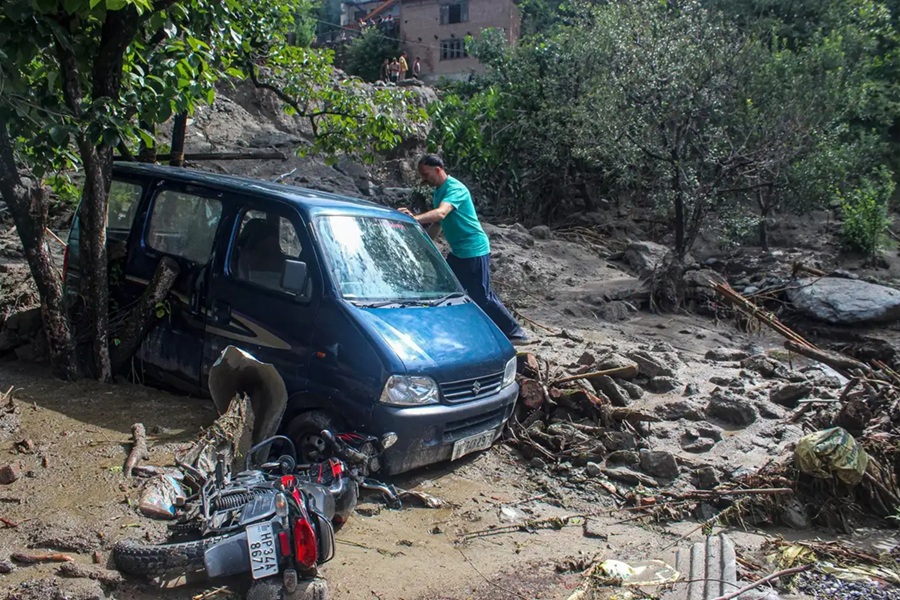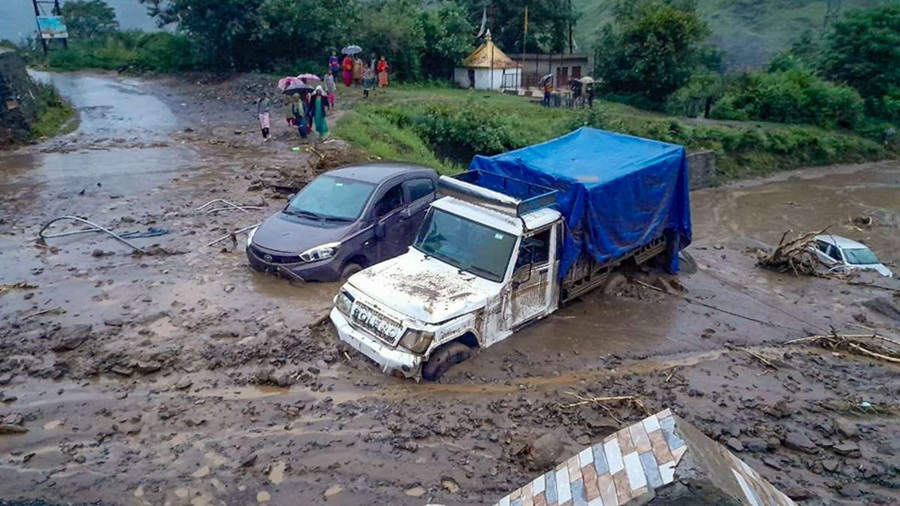A sudden and severe cloud burst struck the scenic town of Rampur in the Shimla district early on Saturday morning, causing flash floods, landslides, and widespread devastation across large parts of the region. This unexpected weather calamity has severely affected life and property, prompting urgent rescue and relief operations by the Himachal Pradesh government and central agencies.
Sudden and Intense Cloud Burst
At approximately 3:45 AM on 24 May, Rampur and its surrounding villages experienced an intense cloud burst, bringing nearly 120 mm of rain within just one hour. This extreme precipitation overwhelmed the local water channels feeding into the Sutlej River basin, resulting in sudden flooding and soil erosion on the mountain slopes.
Villages such as Dutt Nagar, Nirath, and Rampur Bushahr bore the brunt of the calamity, with houses, shops, and farmlands either submerged or destroyed. The rapidly swelling streams turned into deadly torrents, sweeping away bridges, roads, and vehicles, cutting off several pockets from regular communication and transport links.
Human Cost and Rescue Operations
The latest reports confirm at least 12 fatalities and more than 30 people missing. Rescue operations were immediately launched with the deployment of the Himachal Pradesh State Disaster Response Force (SDRF), Indian Army, Indo-Tibetan Border Police (ITBP), and local volunteers. Helicopters from the Indian Air Force have been actively ferrying stranded residents to safer zones, and inflatable boats have been used to rescue those trapped in flooded areas.

Chief Minister Sukhvinder Singh Sukhu, who arrived in Rampur by helicopter on Saturday noon, visited relief camps and assured families affected by the disaster of government support. “Our priority is saving lives and restoring normalcy,” he said, emphasizing the urgency of preparedness and cooperation across agencies.
Infrastructure Damage and Communication Breakdown
The cloud burst severely damaged critical infrastructure. Several key bridges and roads, including parts of National Highway 5, were washed away or blocked due to landslides, isolating many villages. Power supply lines were snapped, plunging thousands of households into darkness, while mobile and internet services remain disrupted in many remote areas.
Local authorities have deployed repair teams, and some connectivity has been restored to facilitate coordination. Meanwhile, emergency shelters have been set up in schools and community centers across Rampur subdivision to accommodate displaced families.
Meteorological Insights and Climate Concerns
The India Meteorological Department (IMD) had predicted moderate rain but did not anticipate such an intense cloud burst. The IMD has now issued a red alert for Shimla, Kinnaur, and Kullu districts for the next 48 hours due to continuing unstable weather conditions.
Experts highlight that the Himalayan region is increasingly vulnerable to extreme weather events like cloud bursts, driven by climate change. Dr. Priya Kaul, a climate scientist at the Indian Institute of Atmospheric Sciences, explained, “These sudden cloud bursts are becoming more frequent and intense, challenging existing disaster management frameworks. This calls for urgent modernization of forecasting systems and community awareness programs.”
Eyewitness Accounts and Local Impact
Many residents of Rampur recount the terrifying experience of being caught unprepared in the dead of night. “The water came like a wall, destroying everything in its path. We barely escaped,” said Rajesh Negi, a local shopkeeper.
Tourists trekking in the area also faced peril. A group of trekkers from Pune reported their campsite near Nirath was completely swept away. “We managed to climb to higher ground and called for help,” said Anjali Mehra, one of the trekkers.
Government and Community Response
The Himachal Pradesh government has announced an immediate ex gratia payment of ₹4 lakh to the families of the deceased and promised compensation for damaged property. A Special Cloudburst Recovery Task Force is being set up to assess damages and expedite rehabilitation efforts in collaboration with central government agencies.
Local NGOs, religious organizations like Khalsa Aid, and youth groups have mobilized relief efforts, supplying food, blankets, and medicines. Social media campaigns have helped channel donations and volunteers from across the country.
Looking Ahead: Preparedness and Future Challenges
The Rampur cloud burst serves as a wake-up call for enhanced disaster readiness in the Himalayan belt. The IMD forecasts continued spells of heavy rain over the next week, with the potential for additional landslides and floods in vulnerable zones.
State authorities are expected to revisit disaster management protocols, emphasizing early warning dissemination, infrastructure resilience, and community-based training programs. Hydrologists advise a halt on construction activities near riverbanks and deforested slopes until safety assessments are complete.
Experts recommend upgrading forecasting capabilities to provide hyperlocal, real-time alerts, and enforcing stricter environmental protections to minimize the impact of future extreme weather events.
Conclusion
As Himachal Pradesh grapples with the aftermath of the Rampur cloud burst, the focus remains firmly on saving lives, restoring infrastructure, and strengthening future preparedness. This calamity is a stark reminder of the challenges posed by climate change in the fragile Himalayan ecosystem — urging immediate action at local, state, and national levels.
